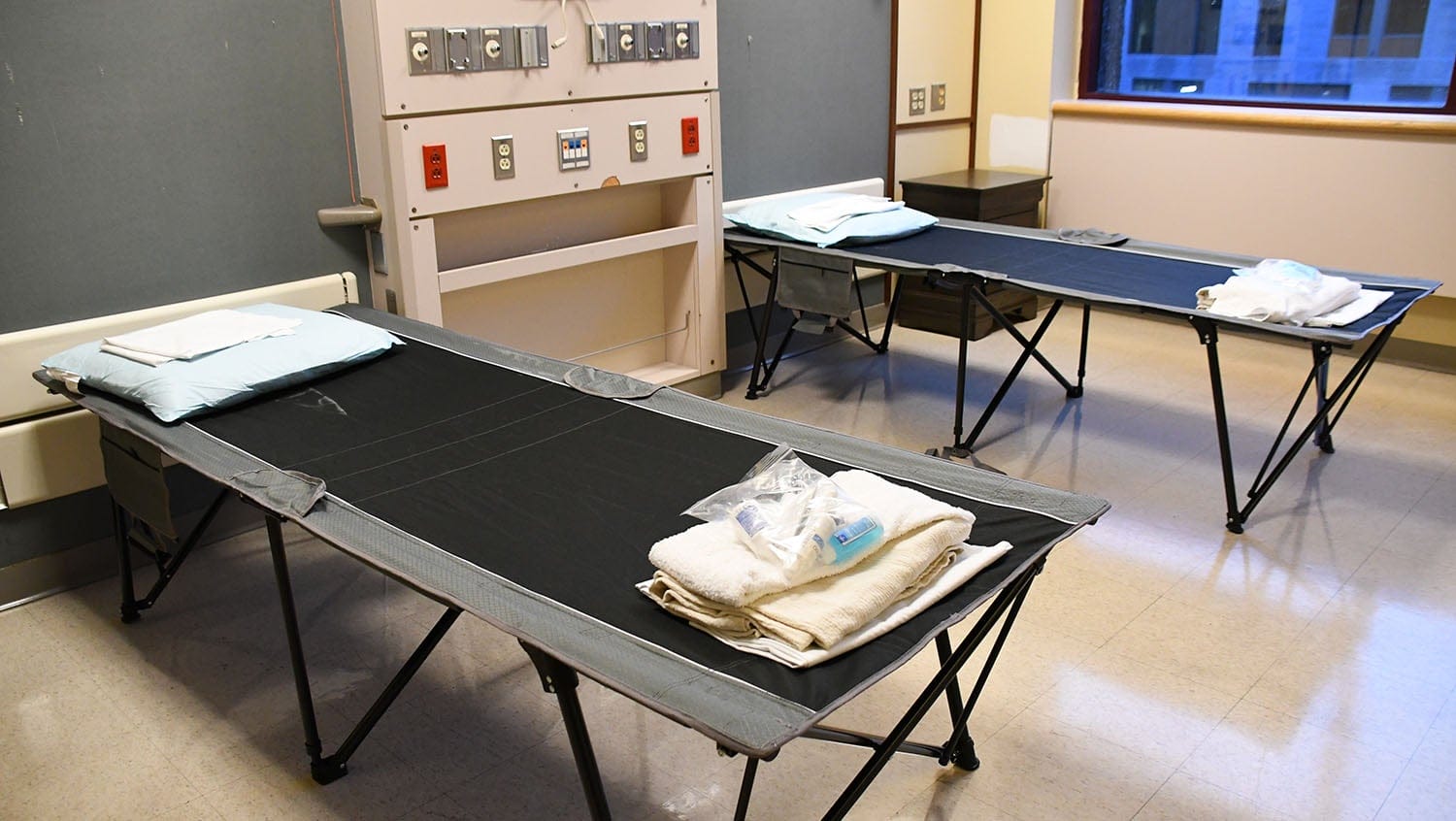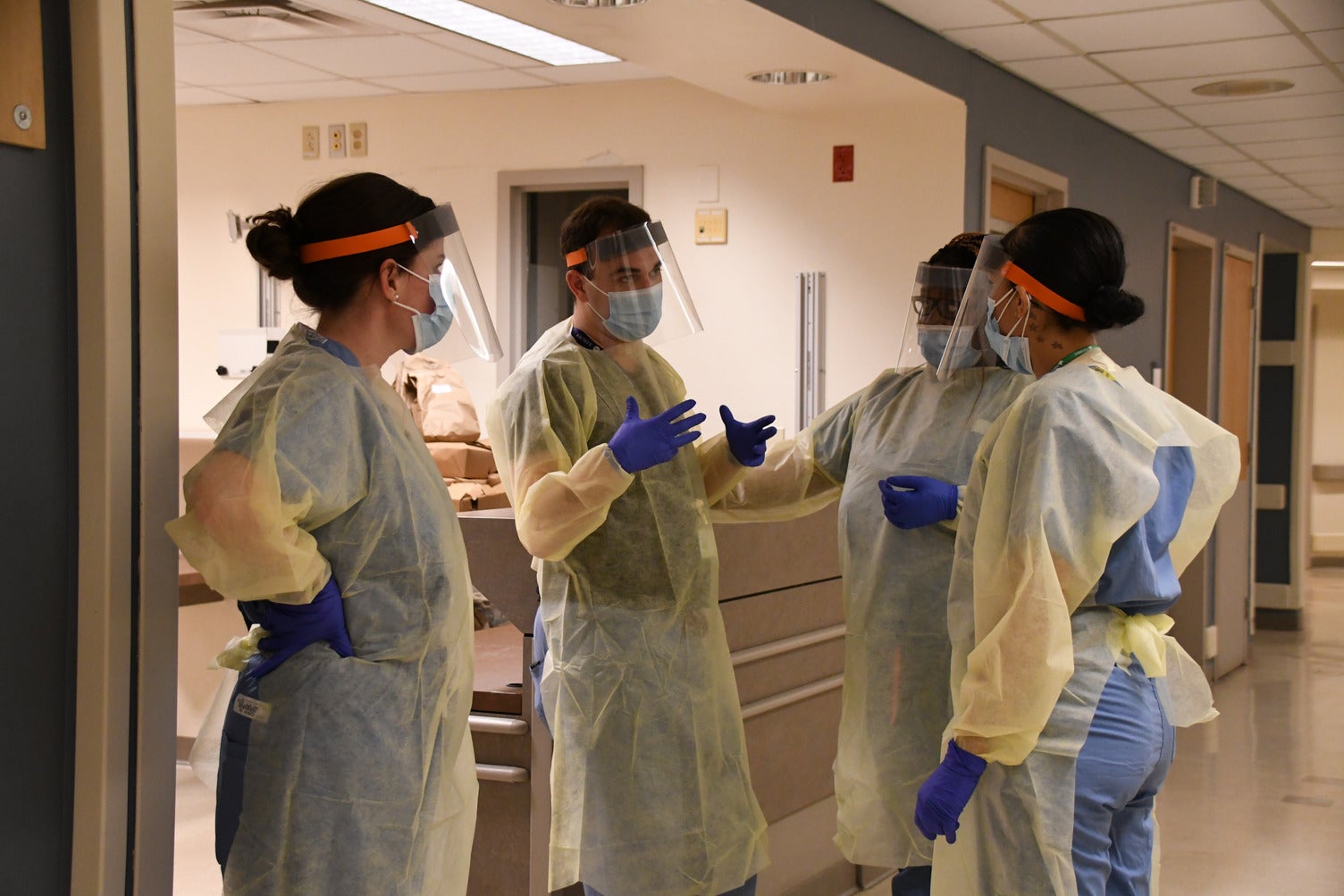Lessons Learned from BMC's COVID-19 Recuperation Unit for Patients Experiencing Homelessness
February 9, 2021

Erlyn Ordinario, BMC Nursing
BMC created a medical unit to provide homeless, COVID-positive patients who were not sick enough to need hospitalization a location to recuperate.
During the first initial surge of COVID-19 in early 2020, the Commonwealth of Massachusetts loaned the then-vacant East Newton Pavilion back to Boston Medical Center (BMC) — after it sold the building in 2018 — to establish a point of care for people experiencing homelessness during the pandemic. Together with partners, including Boston Health Care for the Homeless, the Boston Public Health Commission, and leaders from local shelters, BMC stood up a unit to provide for patients who were COVID-positive and who were not sick enough to need hospitalization, but for whom there wasn’t a safe home or location to recuperate. In other words: the patients who fell into a gap in existing COVID-19 care models.
And it was crucial timing. In the two weeks prior the opening of the COVID-19 recuperation unit at the newly re-opened East Newton Pavilion, a study of 406 persons experiencing homelessness in Boston showed that 36% of them were COVID-19-positive.
The unit was not a “full-fledged” hospital unit — it didn’t, for example, have the capacity to intubate patients. It was bedded outpatient care, staffed 24/7 primarily by furloughed medical staff, BMC physician volunteers, and some contracted physicians. A harm reduction specialist and counselors were also involved.
The recuperation unit cared for 226 patients over an 8-week period, with each patient staying for an average of 8 days. Almost 80% had a co-occurring mental health diagnosis and 40% reported actively using substances at the time of admission. The majority, 74%, were male.

In a recent panel discussion with nonprofit RIZE Massachusetts, Miriam Komaromy, MD, medical director of the Grayken Center for Addiction at BMC broke down the accomplishments of the COVID-19 recuperation unit as well as the lessons learned from the endeavor.

Miriam Komaromy, MD
“The COVID-19 recuperation unit clearly helped to avoid exceeding hospital bed capacity during the epidemic’s surge. Our hospital was teetering on the edge of exceeding its capacity during that early spring surge of 2020. The fact that we could triage patients who had come into our emergency department with COVID infections to this safe place to recuperate under medical supervision, rather than admitting them to the hospital, made a critical difference.
We contended with significant substance use disorder issues. One being frequent withdrawal when patients who are actively using substances are plucked unexpectedly out of their native environments. We had assessment and treatment available 24/7. Also, patients came in with very complicated SUD and behavioral health issues. And so, we had availability of addiction consultation using video technology from the addiction specialist at our hospital to our recuperation unit.
When people have opioid use disorder, treatment with buprenorphine or methadone has been shown to prolong life and improve a variety of outcomes. We prescribed buprenorphine to patients coming in the door with opioid use disorders, and we also wanted to be able to provide methadone for patients who preferred this or for whom buprenorphine was not appropriate. We initially obtained methadone by a take-home supply for patients who were already enrolled in opioid treatment programs, but we also wanted to be able to initiate methadone treatment. In meetings with the DEA and our inpatient pharmacy leadership, we were actually able to obtain permission to do new starts on methadone for those patients in our unit, which was exciting and a positive development.
We had a major focus on harm reduction to try to help patients to stay safe, even if they continued to use drugs. There was debate among staff around the advisability of providing sterile injection supplies at the time of admission, and we ultimately compromised on offering naloxone for overdose prevention throughout their stay and harm reduction equipment to clients at the time of discharge.
Finally, I want to address the pros and cons we learned of the COVID-19 recuperation unit.
Using this model, we are sure that we were quite successful at preventing spread of infection. Patients, once they came into the unit were expected to stay in the unit; and because they could not come and go, there was little risk of contagion to people outside of the facility. Within the facility, staff all wore full personal protective equipment (PPE), but the patients did not have to because they were all infected with COVID.
We were also able to meet complex medical needs and treat substance use disorders and behavioral health issues successfully. We’re especially proud that we were able to arrange to dispense methadone, and we initiated methadone treatment in a number of patients with OUD during their stay in the COVID recuperation unit.
I’m also happy to report that there were no deaths in the unit.
All of the patients who came into the unit were homeless at the time of admission, but for about a quarter of them, we succeeded in not discharging them to the street or a shelter, but instead we were able to place them with family or in residential treatment programs at the time of discharge.
Five percent of patients did develop serious complications and were transferred to BMC — the emergency department was just two blocks away. We did have 7 patients who experienced an overdose during the time that they were in the facility. All of them were successfully reversed.
On the downside, harm reduction was quite difficult. Patients were not able to come and go largely because of concerns about infection, but this also complicated what harm reduction means under those circumstances. There was conflict among staff about how to address ongoing drug use in this setting. In addition, the presence of security onsite was challenging, as there was a considerable culture clash between the security personnel who were present in the unit and the harm reduction goals.
And finally, some patients did not need the level of medical intervention that we offered, and it would be prudent to consider offering a mixed model with both clinically based care and also a hotel-based option.”
*This is only an excerpt of Miriam Komaromy’s presentation.


